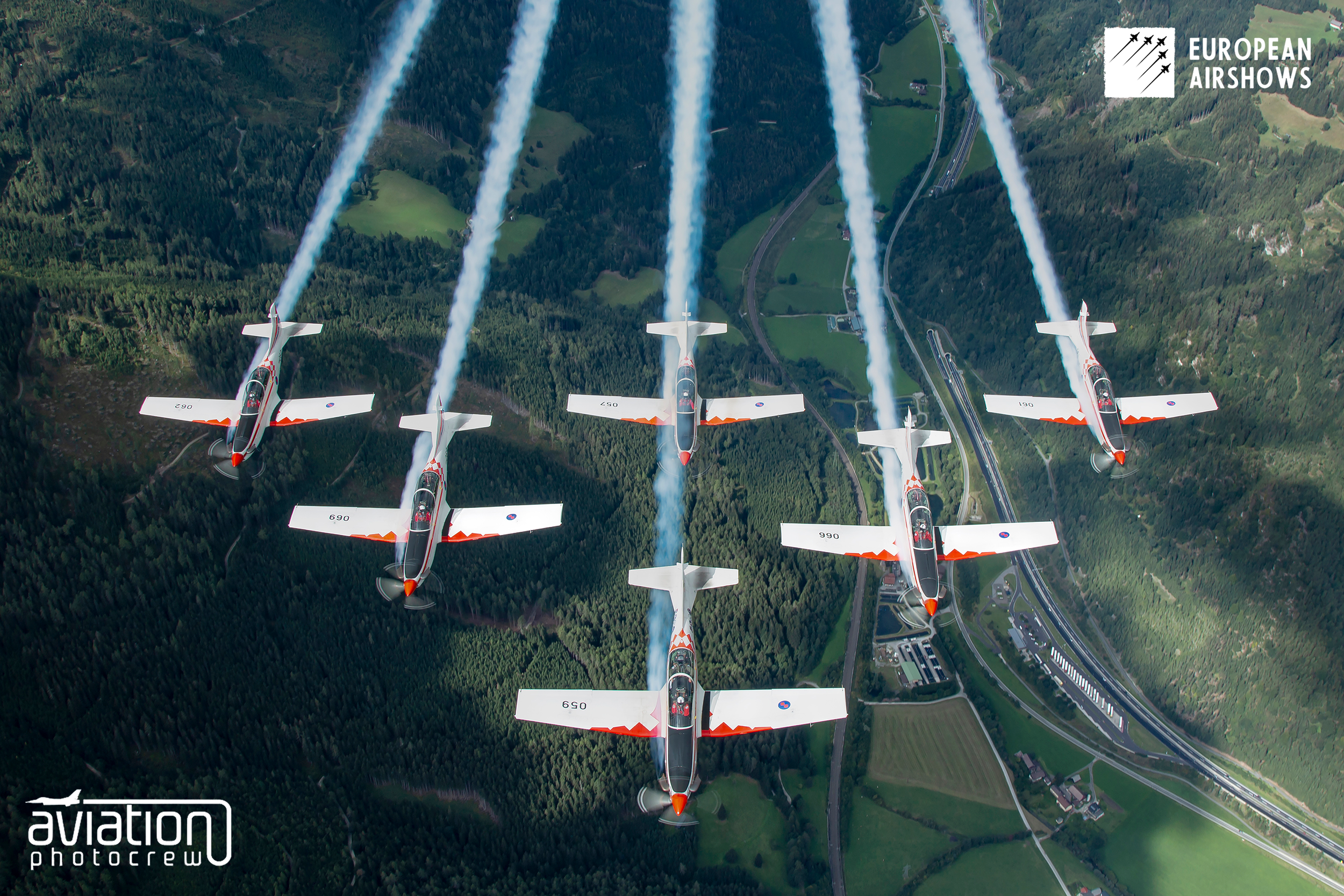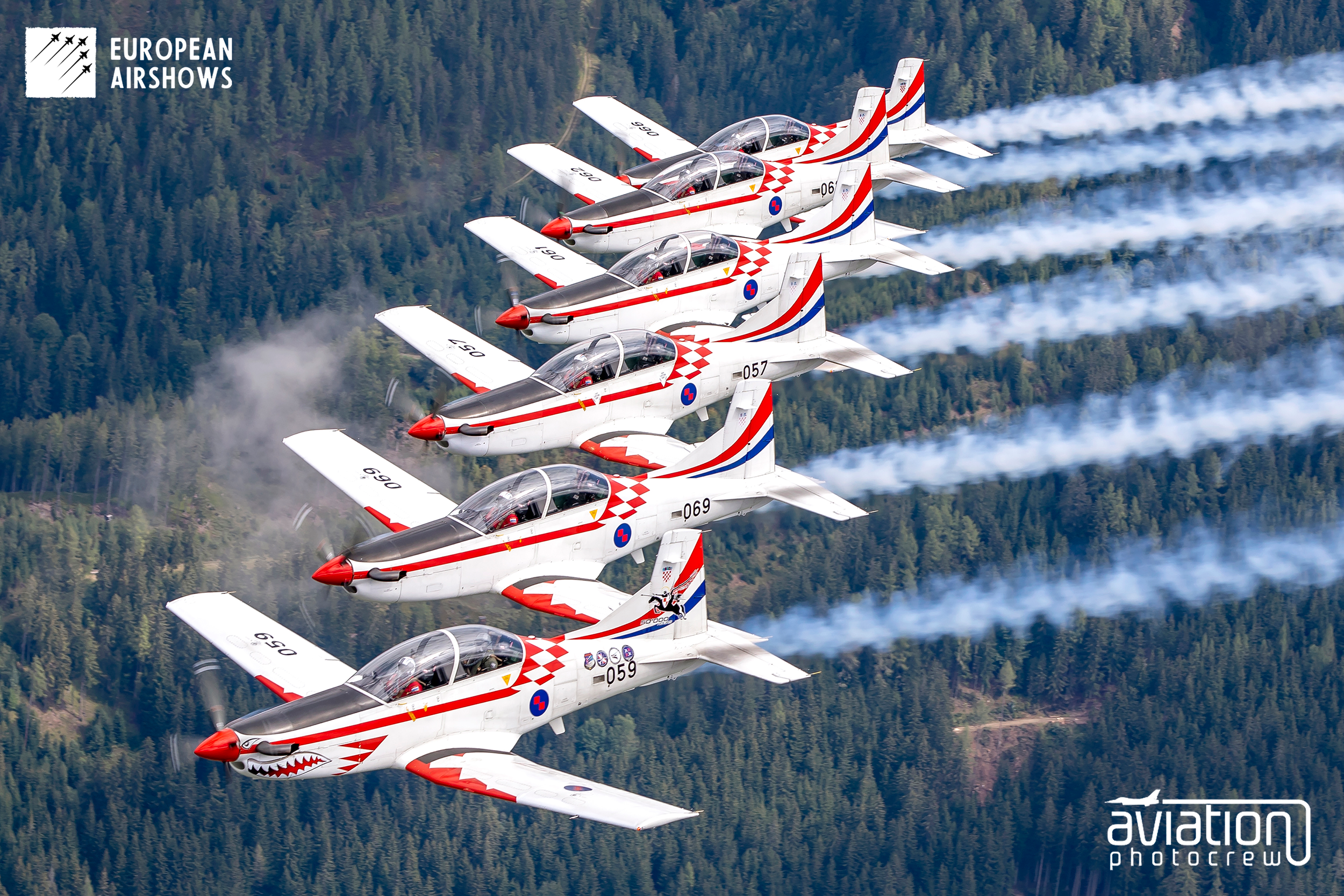
July 5 / Krila Oluje formed
Formed 5 July 2004
Krila Oluje
Krila Oluje, translated as “Wings of Storm,” serves as the official aerobatic display team of the Croatian Air Force. Established on July 5, 2004, the team has swiftly risen to prominence within the global military aviation community, showcasing the exceptional skill and precision of Croatian pilots on an international platform.
The team comprises six instructor pilots from the 93rd Military Airbase in Zemunik, operating six Pilatus PC-9M turboprop training aircraft. Notably, Captain Diana Dobos, who served with Krila Oluje from 2005 to 2007, became the third woman globally to fly in an aerobatic team. The inception of Krila Oluje can be traced back to the early 2000s when the Croatian Air Force aimed to establish a unit that would serve dual purposes: enhancing public relations and fostering national pride. Additionally, the formation of the team was envisioned as a means to augment the training and operational capabilities of its pilots.
The team’s debut performance occurred on July 22, 2004, during the opening ceremony of the European Sailing Championships in Zadar, featuring a four-aircraft display. The initial team was composed of seasoned pilots from the Croatian Air Force, each with extensive aviation experience. These pilots underwent rigorous training to master the intricate manoeuvres and formations that would become synonymous with Krila Oluje’s performances. The team’s name, “Wings of Storm,” was officially adopted following their impressive display at the 10th anniversary celebration of the military and police operation known as ‘Oluja’ on August 5, 2005. By the end of that year, the team expanded to include an additional aircraft, with another added in 2009. The team executed its first six-aircraft formation display on March 25, 2009.
Krila Oluje’s display routine, lasting 23 minutes, is renowned for its complexity and precision. The routine includes manoeuvres such as formation tailslides and formation spins, with aircraft flying less than two meters apart at speeds reaching up to 550 km/h. The pilots endure G-forces ranging from -2.5 g to +6.5 g. The team’s performances are universally acclaimed, earning accolades for their precision, creativity, and seamless coordination.
Over the years, Krila Oluje has continually evolved, incorporating new manoeuvres and techniques to keep their displays fresh and captivating. A cornerstone of the team’s success is its unwavering commitment to safety and professionalism. Strict safety protocols and extensive rehearsals ensure that each performance is executed flawlessly, earning Krila Oluje a reputation as one of the premier aerobatic teams globally.
Beyond public performances, Krila Oluje plays a crucial role in the training and development of Croatian Air Force pilots. The experience gained from flying with the team equips pilots with valuable skills applicable in both combat and peacetime operations. Furthermore, the team’s participation in international airshows serves as a platform for promoting Croatian aviation and fostering diplomatic goodwill.
Throughout its history, Krila Oluje has navigated various challenges, including personnel changes. On March 4, 2015, all six pilots requested to end their military service, effectively disbanding the team shortly before its tenth anniversary. Reports indicated that the pilots had received a superior offer from Qatar to fly the more advanced PC-21 aircraft.
Despite these setbacks, Krila Oluje was reformed with new pilots in 2015 and continues to represent the Croatian Air Force with pride and excellence. The reconstituted team made its debut at the Royal International Air Tattoo (RIAT) in 2016, the world’s largest military airshow, winning the “King Hussein Memorial Sword” for the best overall flying demonstration. In 2017, the team was awarded for the most precise flying demonstration at the Slovak International Air Fest (SIAF).
Krila Oluje stands as a testament to the skill, dedication, and professionalism of the Croatian Air Force, continually inspiring national pride and international admiration through their breathtaking aerial displays.
Krila Oluje Facts
Formation: Krila Oluje was officially formed on July 5, 2004. The team was established to showcase the skills of Croatian Air Force pilots and to represent Croatia at international air shows and events.
Aircraft: The team flies the Pilatus PC-9M, a Swiss-made turboprop trainer aircraft. Known for its agility and reliability, the PC-9M is well-suited for performing complex aerobatic manoeuvres.
Base of Operations: Krila Oluje is based at Zadar-Zemunik Air Base, located near the city of Zadar on the Adriatic coast. This base is also home to the Croatian Air Force’s pilot training school.
Team Composition: The team typically consists of six pilots, each with extensive experience in both flying and aerobatics. The team also includes ground support personnel responsible for aircraft maintenance and logistics.
Distinctive Smoke Trails: During their performances, Krila Oluje uses white smoke to enhance the visual impact of their manoeuvres.
Precision and Discipline: The team’s manoeuvres require a high degree of precision and discipline. Pilots must maintain exact formations and execute complex aerobatic sequences with perfect timing, often flying just meters apart from each other.
International Presence: Krila Oluje has performed at numerous international air shows and events, earning acclaim for their skilful displays. They have represented Croatia in countries across Europe, contributing to their international reputation.
Training and Preparation: The team undergoes rigorous training to prepare for their performances. This includes both flight training and ground-based simulations to practice manoeuvres and ensure safety.
Cultural Significance: Krila Oluje holds cultural and national significance in Croatia. Their performances are often part of national celebrations and events, symbolizing the pride and capabilities of the Croatian Air Force.
Innovative Maneuvers: The team is known for its innovative and dynamic aerobatic routines. Some of their manoeuvres include synchronized formation stall turns, spins and tailside as well as their signature six-ship mirror pass, all designed to captivate audiences and demonstrate the pilots’ exceptional skills.












